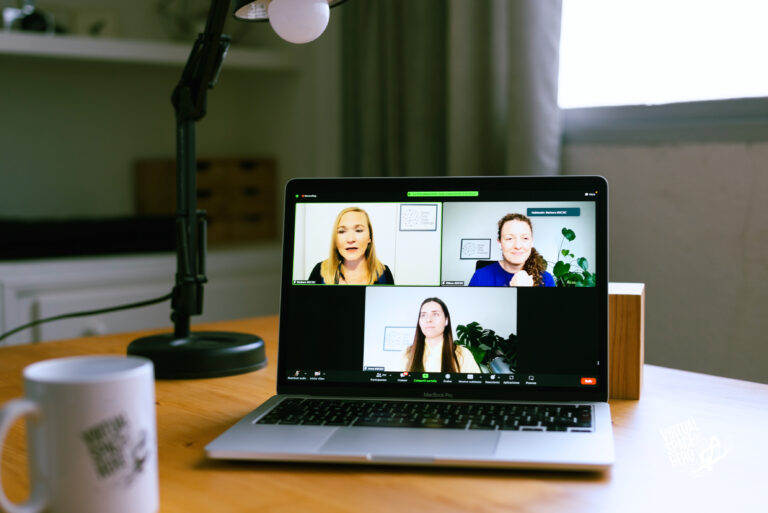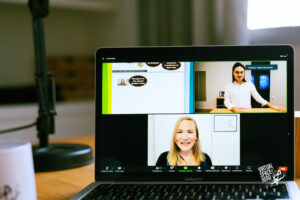Of course! The day will come when we will again be able to decide freely how and where to hold a meeting. But one thing is already clear: in presence meetings will be much less frequent. Instead, we will get used to mixtures of remote and face-to-face.
We need to consider that a hybrid meeting will be good if it is possible to consciously use the spatial proximity of individual participants without neglecting to involve everyone as equally as possible.
To start with, what is a hybrid meeting anyway?
We call a meeting hybrid when at least two participants physically participate in one place while others are from at least one other place.
In this article we will focus on the 5 success factors for a really good hybrid meeting. A good recipe needs good basic ingredients. For a good hybrid meeting, these are the following:
1. Technology
2. Equal participation & Inclusion
3. Defined roles
4. Useful methods
5. The secret sauce for your hybrid meeting… more on this at the end of the article
1️ Technology: the basics
Without technology, virtual collaboration is simply impossible (at least as long as we don’t have end-to-end telepathic capabilities ?). Hybrid meetings further exacerbate the demands on technology. For a hybrid meeting to succeed, we need to start with the basics:
👉 The distance is bridged by a video conferencing system such as .B Zoom, Teams, Webex or GotoMeeting.
👉 In order for everyone to be able to see and hear themselves equally well, cameras, microphones and loudspeakers are needed, each of which clearly transmits the speaker.
👉 Remote participants ideally use an external webcam and headset. Alternatively, echo-cancelling internal or external microphones and speakers also work. For good sound, take a look at krisp
👉 On-site participants can ideally follow both the events in the room and the activity in the video conference well. There are special devices with advanced intelligence for this: These are room cameras, microphones and loudspeakers that smartly zoom in on and record or reproduce the speakers (e.g. Meeting Owls). At the same time, however, there are also simpler solutions. These are your own laptops or tablets, depending on the meeting design, a smartphone can also be sufficient. Headsets are useful when mixed group work (on-site and remote participants) is planned in breakouts. It is important that only one room microphone (or several paired ones) and room speakers are active at a time, otherwise, you will have a lot of echoes and lops. The individual (laptop) microphones and speakers must be muted.
👉 The facilitator needs a laptop with a split screen or an additional screen so that he/she can keep an eye on both the video conference and the document to be discussed or edited (PowerPoint, virtual whiteboard, etc.). Highly recommended is the use of a room camera (either smart options such as a Meeting Owl or simply another external webcam) that records the people in the room. For the moderation to be clearly visible and audible in any case, he/she should use his/her own webcam.

And another tip for the facilitator:
As a facilitator, it is best to choose your place in the room in such a way that the wall with projector image or the room screen is in your back and the participants sit in front of you. On the table in front of you, you then have the laptop with external webcam and a split screen (or 2nd screen), so that you can keep a good eye on everything:




A good meeting is characterized by interaction. This is where a digital whiteboard comes into play where your on-site and remote participants work together, e.g. Miro, Conceptboard or Jamboard.
All the smart technology is not (yet) available? Then consciously decide what is more important: to use the spatial proximity of some or to enable as much equality as possible in the meeting.
“Under certain circumstances, the “one remote = all remote” approach can make more sense than a technically unfavorable hybrid setup.”
 Want to know “How to create interaction with breakout rooms in your virtual sessins?”
Want to know “How to create interaction with breakout rooms in your virtual sessins?” 2️⃣ Inclusion in hybrid meetings: the equal participation right for all!
I am convinced that meaningful results in meetings in general can only be achieved if everyone feels addressed and included. In hybrid meetings we need to consider a few more things to make this happen.
👉 Inform everyone in advance about which tools are used. For example, if you want to actively work on digital whiteboards such as Miro, everyone should try to sit at the notebook or computer (whiteboards just don’t work well on tablets, yet…)
👉 Start your meeting with a good check-in where everyone gets space to be seen and heard. Make sure everyone is onboarded properly to the whiteboard being used.
👉 Agree on meaningful meeting rules. My number one important rule here: “Remote first”. In this case, the remote participants would always answer an open question first. I would also recommend designing all aspects around a hybrid meeting considering the remote participants first. We do know that on-site participants more easily feel engaged and participate in discussions as the barrier is just smaller.
👉 An evenly rotating composition within a team between remote participants and on-site participants can compensate for the advantages and disadvantages – is it possible for everyone to be on site at some point?
👉 I talked about the appropriate technology in point 1 – is it foreseeable that a large part of your meetings will be hybrid? Then a corresponding investment makes perfect sense. Thanks to intelligent technology, everyone can look each other equally well in the face and therefore be at “eye level”.
👉 Don’t forget to use asynchronous communication as well in your hybrid meeting design. Your participants can read and prepare for the meeting and will therefore also be more engaged when the login or enter the meeting room. In the meeting, you can then concentrate on the discussion.
3️⃣ Meeting roles – who is actually doing what here?
Without a clear distribution of roles and tasks, a hybrid meeting will hardly be a success. Therefore, determine in advance or at the latest at the beginning of the hybrid meeting who is responsible for what:
👉 The facilitator has the task of staying on track and make sure you are focusing on the meeting goal again by using suitable methods to achieve this goal
👉 The producer or co-facilitator or technical assistant ensures that all questions about the technology are answered, such as “I have no sound, I don’t see the board”… He/she takes care of parallel discussions in the chat, posting important technical information, such as the links to whiteboards and also creates breakout rooms for smaller group interaction.
👉 The timekeeper keeps an eye on the overall time ⏱️, but also of the individual agenda items. He/she reminds the facilitator how much time is left for an agenda item. This of course, can also be done by the facilitator.
👉 The Feel good & Energy keeper: It’s time for a break, but no one says anything? It is the job of the Feel good & Energy keeper to ensure that enough breaks are made, especially in longer workshops or meetings.
👉 The Minute Man/Woman: A result that no one remembers is forgotten easily. The Minute Man/Woman is the one in charge to document the results during the meeting, visible to everyone. Thus, no further coordination is necessary afterwards and everything relevant has been recorded already.
Of course, all roles can also be filled by one person, but this can be easily overwhelming. With distributed roles, the burden of managing the whole meeting is not as usual on the shoulder of the team leader but distributed across the participants. Consequently, everyone feels more involved and furthermore develops also the competencies needed for a hybrid work setting.
4️⃣ Facilitation methods that make sense– or how do we actually achieve our goal?
Method number 1 in most meetings is free floating discussion. However, it is only one of many possibilities. Besides, it is rarely the best.
Think before about the actual goal of the meeting and the different agenda items. Then define facilitation methods that best support you to reach the goal. There are so many facilitation methods that they would blow up this article. Therefore, at this point only my two favorites:
For decision making: There are countless ways to make decisions (and not make them). In hybrid meetings, the Consent principle from sociocracy often works well. As long as no one says, “I have a serious objection to….”, the decision is taken.
For creative processes: When it comes to developing new ideas, brainstorming or brainwriting is usually used. In addition to these evergreens, our favorite is 124-all from the “Liberating Structures”. This technique invites everyone to think first for themselves, then in pairs, then in four and only then it is shared in the large group. As a result, ideas go through several quality-improving stages, and everyone has their say.
5️⃣ The secret sauce for your hybrid meeting: awareness of what you are doing!
A hybrid meeting is a space where people interact. This space can be consciously designed!
If you do not invest energy in a suitable choice of facilitation methods, you are for sure very fast in preparing the meeting, but with a high probability the meeting itself will be less successful. If you do not consider how to include everyone by conscious decisions on your facilitation methos, it allows extroverts a big stage and prevents introverts from bringing in their point of view.
In virtual meetings power is balance. No one has a bigger desk or the better chair. In hybrid meetings, it can easily happen that the on-site participants are more actively involved than the remote participants on the screen due to their physical presence. The facilitator should counteract this and consciously choose methods that counteract this imbalance of power. For example, remote participants are always the first to speak.
Hybrid meetings are a challenge! But at the same time, they offer the opportunity to combine the best of both worlds – presence and online.
Are you aware that hybrid collaboration is about much more than hybrid meetings?





